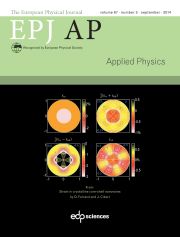Article contents
Vacuum microelectronics devices based on the controlled electron motion in electric andmagnetic fields
Published online by Cambridge University Press: 15 April 2000
Abstract
Several novel field emission devices are analyzed in a unitary way. The devicesinvolve the use of field emitter arrays in a special configuration where the emittedelectrons are subject to crossed electric and magnetic fields. Due to the acting electricand (magnetic) Lorentz forces, the electrons are either deviated or have a cycloid-likeconfined motion. The angular deviation of the electron trajectory can be used for measuringmagnetic fields. The pulsed electron current produced by a cold cathode can be used togenerate electromagnetic radiation. Because the electrons have a confined motion with a longtrajectory length, their chance of hitting a residual gas molecule is increased. They caneither excite gas molecules, which in turn emit UV-radiation when relaxing back to thestable state, or ionize them, the ionic current being correlated with the gas pressure.Accordingly, devices for generating UV-radiation and vacuum gauges can be devised.Furthermore, if the ion generation takes place in a narrow and well-defined region, thentheir angular deviation can be correlated with their mass. A mass spectrometer (withminiaturized dimensions and field emission electron source) can be devised on thisprinciple.
Information
- Type
- Research Article
- Information
- Copyright
- © EDP Sciences, 2000
References
- 1
- Cited by

